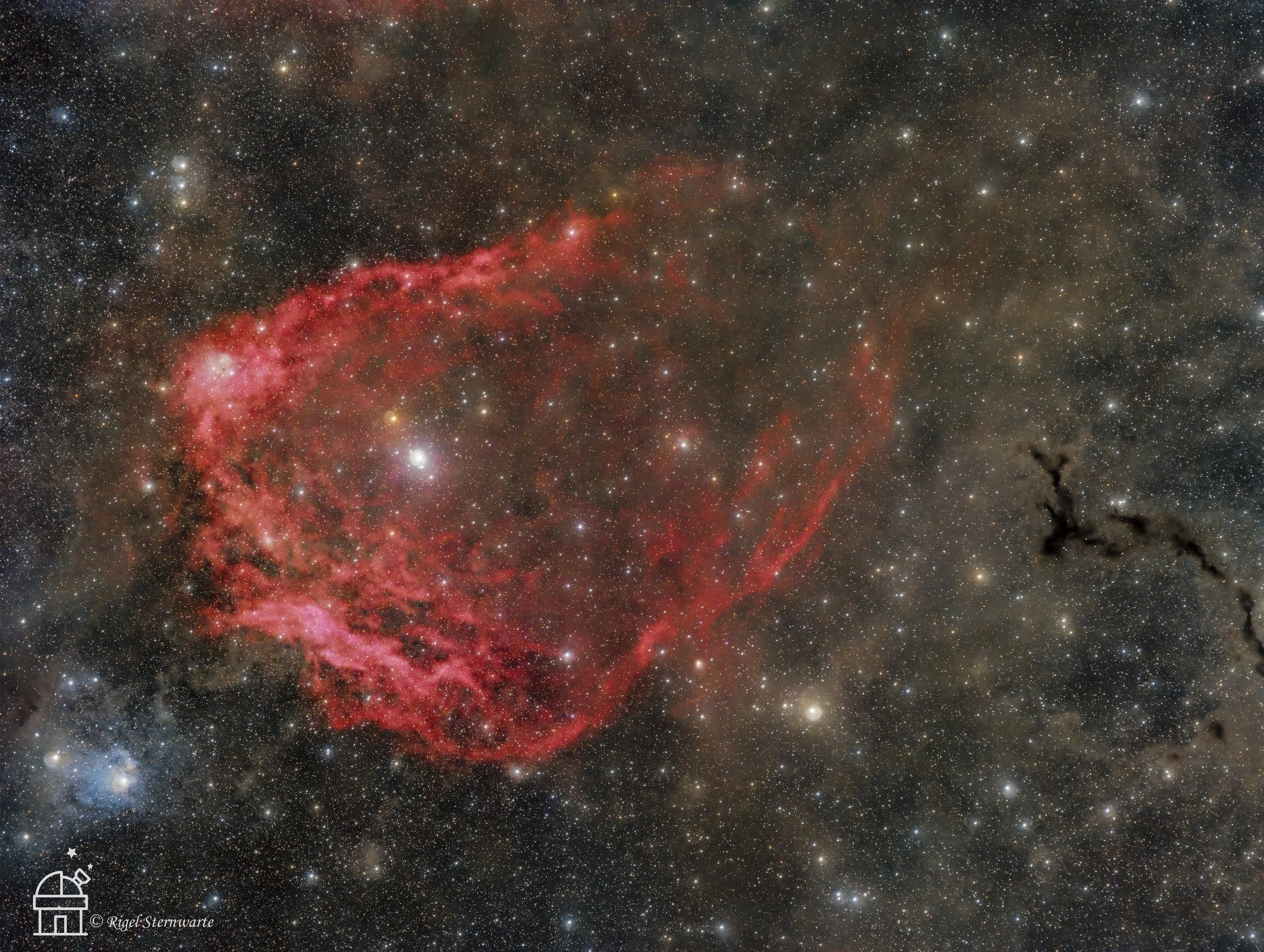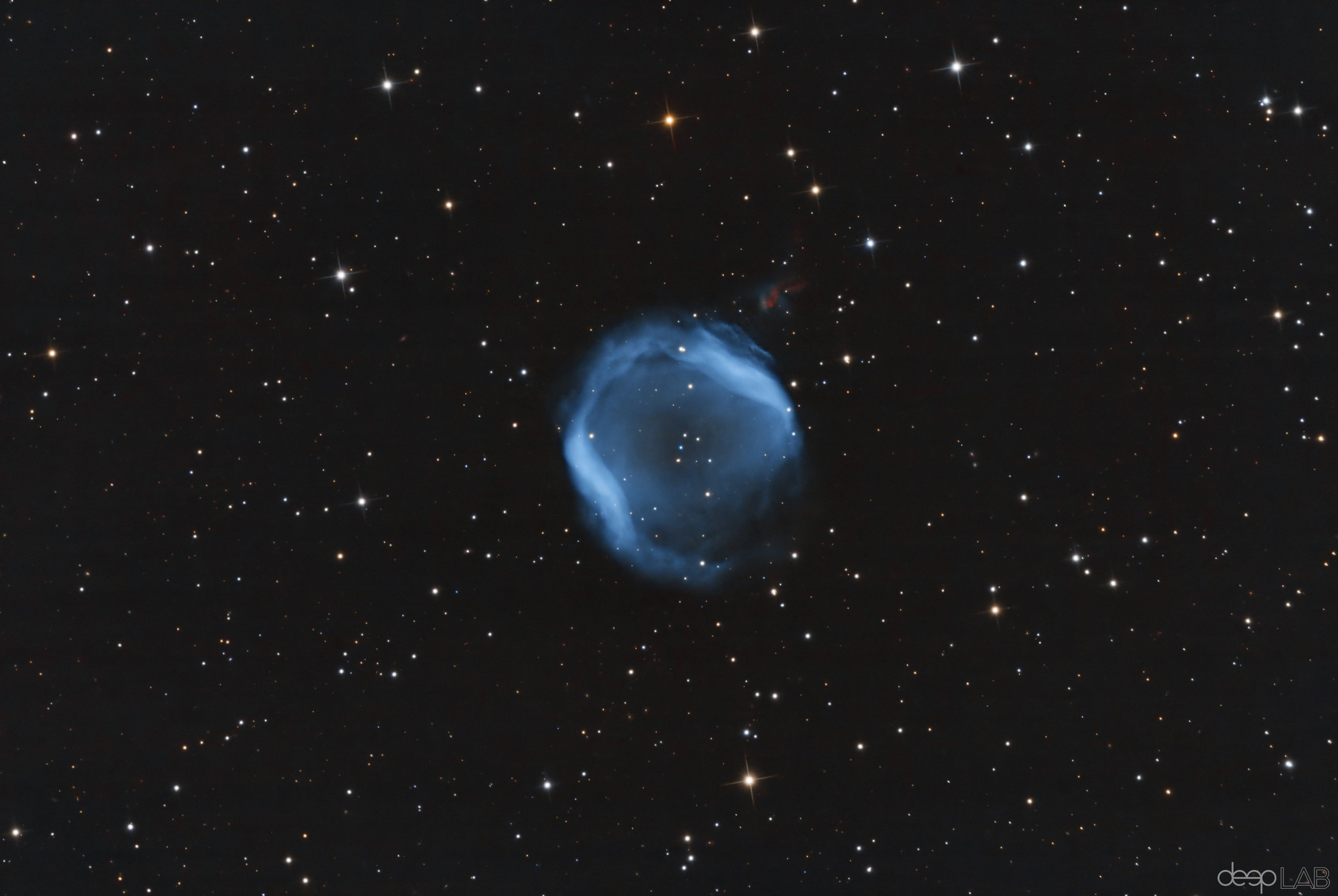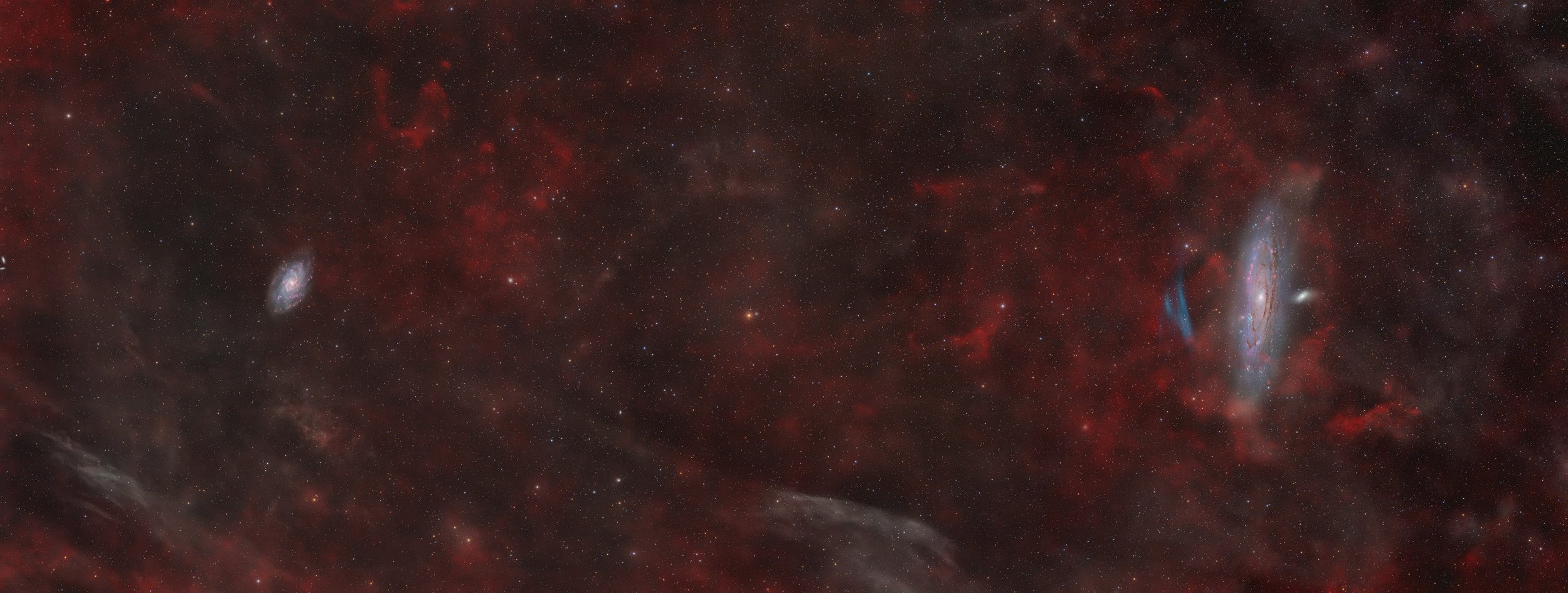
AAPOD2 Image Archives
NGC 7380 - The Wizard Nebula
Image Description and Details: NGC 7380/ SH2 142 - The Wizard Nebula, is an open cluster of stars still embedded in the nebula out of which it formed. The stars are estimated to be about 4 million years old. The cluster is about 8,000 light years away in the constellation Cepheus.
Dusts in Cassiopeia
Image Description and Details: Southeast of the star Shedar, there is a vast molecular nebula area. LBN 603, LDN 1295, LDN1296, and TGU H809 are part of it and as well as others not shown. LBN603 is the 603rd object in the Lynds Bright Nebulae (LBN) Catalog, and the Lynds brightness scale of 1 (brightest) to 6 (dimmest) has this one at a 6. This was captured over a couple nights in October.
Partial Lunar Eclipse 28-29 October 2023
It was the last Lunar eclipse of the year and I tried to capture it successfully. As soon as it starts entering the umbral region, a dark shadow starts overlapping the moon and making it look like a "Bitten Biscuit." As the Umbral eclipse starts, the bands slowly turn orangish red and the shadow starts overtaking the brightness the Moon until it gets fully covered. The eclipse has no such effect on human beings as the rumours and superstitions roam around. The events of nature are meant to be enjoyed together.
SH2-119. The clamshell nebula
Location: Castillejar, Andalusia, Spain
Image Description and Details: 2200 years ago, when the photons of light left this nebula to reach us, the Earth was definitely another place. The cosmic time machine, the telescope, this time was pointed towards the constellation Cygnus, more precisely towards Sh2-119. Gas and dust envelop the main star, 68-Cygni being mostly responsible for the ionization of the gas around it. This ionization makes the gases all colored at different wavelengths, from blue to green, passing through all shades of brown and orange. The dark nebula filaments above contrast strongly with both the glow of the nebula and the rich field full of stars in the background. These filaments are clouds containing mostly gas (hydrogen and helium) and a minimal fraction of dust (about 1%), responsible for the appearance of the cloud. These dusts, although minimal, absorb the light, making the nebula completely dark. Sh2-119 is a celestial signature of an ancient explosion that released gas and dust into the universe, forming new stars and planets. The silk effect of the nebula makes us think of a white colored pillow in a bed of stars, but, among that dust, stars and planets are forming in the most violent and destructive processes.
Andromeda in narrow/broad-band with the recently discovered SDSO1!
Image Description and Details: The Fiery Veil of Andromeda!
Gaze upon the Andromeda Galaxy, our cosmic neighbour, as it reveals its hidden secrets. The crimson halo you see is the Ha emission, a testament to the vast clouds of hydrogen gas that envelop this majestic galaxy. It's like Andromeda's own ethereal aura, glowing softly against the backdrop of the cosmos.
Now, let's dive deeper. The inverted image you see is a result of meticulous processing of the data taken using the Radian Triad filter. But what's that faint glimmer to the left? Ah, that's the STROTTNER-DRECHSLER-SAINTY OBJECT 1. Processing this was no easy feat. It was like trying to hear a whisper in a storm. But with a blend of channels, some masking magic, and this ghostly presence was brought to life. Its amazing how the world of Oiii has so much for us unknown.
B150- Fireworks and Dust
Barnard 150 is a dark nebula visible in Cepheus constellation. It is also known as the Seahorse Nebula due to its shape.
Ngc1333 Wide field
Image Title: Ngc1333 Wide field
Image Description and Details: NGC 1333 is a reflection nebula located in the northern constellation Perseus.
This nebula is a young region of very active star formation, being one of the best-studied objects of its type.
NGC 7822
Image Description and Details: Can you see the face in space ? Blue eyes, a dark nose and mouth with curly red hair….
The red in space is ionised hydrogen and blue is atomised oxygen. Cosmic pillars of cold molecular gas and clouds of dark dust – often called elephant trunks – lie within NGC 7822. Powering the nebular glow are the young, hot stars of the Berkeley 59 cluster, whose powerful winds and radiation also sculpt and erode the dense pillar shapes. Stars could still be forming inside the pillars by gravitational collapse, but as the pillars are eroded away, any forming stars will ultimately be cut off from their reservoir of star stuff…..
Solar Eclipse from Texas
Image Description and Details: It was a great experience to enjoy this great phenomenon of nature, although from where I was (Dallas, Tx.) it was not possible to see 100% of this annular solar eclipse, but here I leave you the result of these images taken from my dedicated telescope I hope you like it, and we will wait for the next total eclipse, from Dallas, now we will see it completely in this area, next April 2024.
WR-134
Image Description and Details: WR 134 est une étoile variable située à environ 6 000 années-lumière de la Terre dans la constellation du Cygne. WR 134 expulse une partie de ces couches externes qui sont ensuite soufflées par le rayonnement intense et les vents stellaires rapides de l’étoile. L’éjecta est ensuite entré en collision avec la nébuleuse ambiante entourant l’étoile pour former cette espèce de disque (en bleu dans l’image).
The Nose of the Elephant Trunk
Image Description and Details: This is the cometary globule inside IC1396, in Cepheus. It is named "the elephant trunk" due to the similarity with the trunk of this big animal. The globule contains many different protostars and it is shaped by a very energetic star in the center of the nebula complex. In this image I composed 3 different sessions: SHO and L-Extreme images taken with my C11HD from my backyard and RGB images taken with CDK500 from Skygems remote service.
M 2-55 and its elusive fragmented bow-shock front
Image Description and Details: M 2-55 is an evolved rarely-imaged planetary nebula in the constellation Cepheus. It was first discovered and identified by the German-American astronomer Rudolph Minkowski on photographic plates at Mount Wilson in 1947. The plates were taken by W.C. Miller with a 10" f/5.2 refractor.
IM 2-55 possesses two sets of bipolar lobes.
It was only in 2020 that a team of Chinese professional astronomers detected an arc of material running from the SE to the SSW. (Chih-Hao Hsia et. al, March 13th 2020, “Discovery of Extended Structures around Two Evolved Planetary Nebulae M 2-55 and Abell 2”). They concluded that this arc was furnishing strong evidence for an interaction of the expanding nebula of \m 2-55 with its surrounding interstellar material. The presence of fragmentation in the arc may be the result of a phenomenon known as Rayleigh-Taylor (RT) instabilities.
A total of 115 hours HaOIIIRGB image capture
COSMIC CHECKMARK (LBN534+VdB158)
LBN 534 and VdB 158, located in the constellation Cepheus, together form a captivating interstellar duo offering a wealth of scientific insights. LBN 534 is classified as a diffuse emission nebula, while VdB 158 is a reflection nebula. Emission nebulae, like LBN 534, are primarily composed of ionized gas emitting light at various wavelengths, providing valuable information about the properties of the interstellar medium. VdB 158, on the other hand, owes its striking appearance to the scattering of light by dust particles.
In the case of VdB 158, the bluish appearance is the result of the preferential scattering of shorter, bluer wavelengths of light. Its juxtaposition with LBN 534 offers a unique opportunity for astronomers to study the interaction between the illuminating stars and the surrounding dust and gas. Analyzing these nebulae contributes to our understanding of the intricate processes governing star formation and the dynamics of the interstellar medium in the vast expanse of our galaxy.
SH2-129 LRGB
Sh2-129, also known as the Flying Bat Nebula, is an emission nebula located in the constellation of Cepheus. It derives its name from its resemblance to a flying bat with outstretched wings. Scientifically, Sh2-129 is a complex nebula featuring both emission and reflection components. Emission nebulae are formed by the ionization of gases by nearby stars, while reflection nebulae occur when dust particles scatter light from nearby stars. Sh2-129 is illuminated by the radiation from O-type stars, which are known for their high temperature and luminosity. Its intricate structure provides astronomers with an opportunity to study the interplay between stellar radiation and the surrounding interstellar medium. The examination of Sh2-129 contributes to our understanding of the mechanisms behind the shaping and evolution of such intricate cosmic formations.
2023 October 14 Annular Solar Eclipse in H-Alpha
An annular solar eclipse occurs when the Moon covers the Sun's center, leaving the Sun's visible outer edges to form a "ring of fire" or annulus around the Moon. Observing such an eclipse in H-alpha light, which is a specific spectral line of hydrogen, can provide valuable insights into the Sun's chromosphere and prominences.
For the October 14, 2023, annular solar eclipse, this H-alpha view highlights the chromospheric features and prominences. Observers using specialized solar telescopes equipped with H-alpha filters would have been able to see the eclipse with more details and observe any solar prominences that were present during the eclipse.
SH2-129 and OU4 in OIII-RGB
This composite image features a captivating 2-panel mosaic of the intricate SH2-129 and OU4 nebulae, highlighting their stunning OIII-RGB emission patterns. Through the implementation of specialized filters, the mosaic vividly portrays the intricate interstellar structures and the distinct emission characteristics of these nebulae. SH2-129, also known as the Flying Bat Nebula, boasts dynamic filamentary features, while OU4, the Iris Nebula, exhibits intricate details and a captivating ring-like appearance. The utilization of the OIII-RGB technique enhances the contrast and color separation of the nebular components, providing valuable insights into the ionized gas dynamics and the underlying physical processes driving the evolution of these stellar nurseries.
Comet 103P/Hartley and the Eskimo Nebula
This composite image captures the celestial journey of Comet 103P/Hartley against the backdrop of a starry night sky. The stacked image technique highlights the graceful trajectory of the comet, while accentuating the subtle motion of the trailing stars due to the Earth's rotation. Comet 103P/Hartley, known for its periodic return to the inner solar system, exhibits a distinguishable coma and tail, showcasing its volatile nature as it interacts with the solar wind. The juxtaposition of the comet's transient presence and the steadfast backdrop of the stars offers a profound visual testament to the dynamic and timeless nature of our universe.
PK104-29.1 PLANETARY NEBULA IN PEGASUS
This image provides a comprehensive view of the PK104-29.1 planetary nebula situated in the Pegasus constellation. The image delineates the complex structures and color variations inherent in the nebula, shedding light on its intricate composition and spatial distribution. PK104-29.1, characterized by its distinctive bipolar morphology, offers valuable insights into the astrophysical processes governing the late stages of stellar evolution.
IC1805 - Melotte 15
This deep-space image, captured using the Hubble palette, offers a unique perspective of Melotte 15, a star cluster nestled within the expansive cosmos. Comprising Sulfur (S), Hydrogen-alpha (Ha), and doubly ionized Oxygen (OIII) emissions, the image provides a distinctive, color-enhanced view of the cosmic phenomena. Melotte 15 is renowned for its remarkable stellar richness, harboring a concentration of hot, massive stars, including O-type stars, which are among the universe's most massive. This makes it an exceptional laboratory for exploring the intricacies of stellar evolution and massive star formation. Additionally, within this cluster, various variable stars exhibit periodic changes in brightness, supplying astronomers with valuable data for unraveling the fundamental properties of stars and the dynamics of Melotte 15, enhancing our comprehension of this celestial ensemble.
From Triangulum to Andromeda
This captivating deep-space image spans a vast cosmic expanse from the Andromeda Galaxy (M31) to the smaller yet equally enchanting Triangulum Galaxy (M33). This astronomical composition is a mesmerizing blend of multi-spectrum imagery, seamlessly harmonizing hydrogen-alpha (Ha) and doubly ionized oxygen (OIII) emissions with luminance (L), red (R), green (G), and blue (B) channels. In this breathtaking capture, the fiery tendrils of Ha and the ethereal glow of OIII emissions intertwine with the intricate details of stars and dust, creating a celestial astro-photo that not only reveals the grandeur of these neighboring galaxies but also provides a glimpse into the intricate astrophysical processes shaping the universe.




















